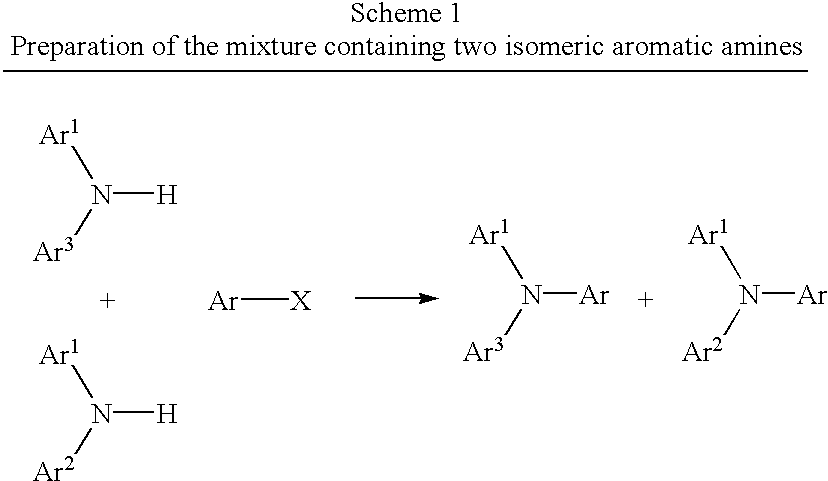Electroluminescent compositions and devices
- Summary
- Abstract
- Description
- Claims
- Application Information
AI Technical Summary
Benefits of technology
Problems solved by technology
Method used
Image
Examples
examples
[0090] The following Examples are provided to further define various species of the present invention. It is noted that these Examples are intended to illustrate but not limit the scope of the present invention.
[0091] Synthesis of the mixture of isomeric aromatic amines
[0092] General Synthesis
[0093] Pd(OAc).sub.2 (0.025% mol %) and P(t-Bu).sub.3 (0.10 mol %) were added to the suspension of aryl halide (40 mmol), isomeric diarylamines (total 44 mmol) (the ratio of per halide is 1.1 diarylamine) and NaOBu-t (48 mmol) in toluene (or xylenen) (50 mL) under N.sub.2 atmosphere. The mixture was heated for 2 to 12 hours at 100.degree. C. Subsequently, the reaction mixture was cooled to room temperature. Water (60 mL) was then added into it. The organic layer was separated. After removal of solvent, the residue was subjected to pass through a silicon gel column to remove the dark color. After removal of solvents and dried, the yield ranges from 85% to 97%. The composition of the mixture of i...
examples 7-14
[0095] Organic EL devices Examples 7-14 were prepared in the following manner:
[0096] 1. An indium tin oxide, 500 Angstroms in thickness, (ITO) coated glass, about 1 millimeter in thickness, was cleaned with a commercial detergent, rinsed with deionized water and dried in a vacuum oven at 60.degree. C. for 1 hour. Immediately before use, the glass was treated with UV ozone for 0.5 hour.
[0097] 2. The ITO above prepared substrate was placed in a vacuum deposition chamber. The deposition rate and layer thickness were controlled by an Inficon Model IC / 5 controller. Under a pressure of slightly less than about 5.times.10.sup.-6 Torr, an aromatic amine or a mixture of isomeric aromatic amines (see examples 7 to 15) was evaporated from an electrically heated tantalum boat to deposit an 80 nanometer (800 Angstroms) hole transport layer on the ITO glass layer 1. The deposition rate of the amine compound was controlled at 0.6 nanometer / second.
[0098] 3. Onto the transport layer of 2 was deposit...
example 15
[0103] EL devices as illustrated in example 8 utilizing the mixture of isomeric aromatic amines IAA-25 as the hole transporting layer and EL device and example 7 utilizing the commonly hole transport material NPB were operated under constant current 33 mA / cm.sup.2 and subjected to temperatures of 25.degree. C., 60.degree. C., and 85.degree. C. for 250 hours. The changes in its current-light intensity characteristics and dark spot growth were checked. The results were list in Table 3.
10TABLE 3 Temperature controlled testing results of EL devices Example 7 Example 8 EL Devices 25.degree. C. 60.degree. C. 85.degree. C. 25.degree. C. 60.degree. C. 85.degree. C. Light out put 10% 25% 45% 10% 22% 38% decay under 33 mA / cm.sup.2 Visual Not Slow Fast Not Very slow Slow observation visiable growth growth visiable growth of growth of dark spots of dark of dark dark spots of dark growth spots spots spots
[0104] These results demonstrate that an organic EL device utilizing a mixture of isomeric a...
PUM
| Property | Measurement | Unit |
|---|---|---|
| Fraction | aaaaa | aaaaa |
| Fraction | aaaaa | aaaaa |
| Fraction | aaaaa | aaaaa |
Abstract
Description
Claims
Application Information
 Login to View More
Login to View More - R&D
- Intellectual Property
- Life Sciences
- Materials
- Tech Scout
- Unparalleled Data Quality
- Higher Quality Content
- 60% Fewer Hallucinations
Browse by: Latest US Patents, China's latest patents, Technical Efficacy Thesaurus, Application Domain, Technology Topic, Popular Technical Reports.
© 2025 PatSnap. All rights reserved.Legal|Privacy policy|Modern Slavery Act Transparency Statement|Sitemap|About US| Contact US: help@patsnap.com



